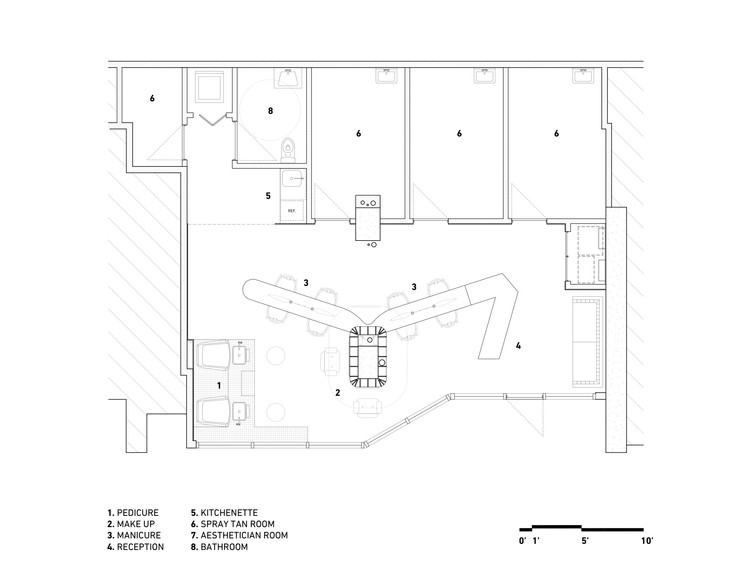Dyv
2013-07-13 01:00
Courtesy of JAPA Architects
JAPA建筑师提供


对亚洲城市的战略反思:自2000年以来,中国的农业用地有限,中国城市的年平均扩张速度为10%。虽然中国的农业产量是世界上最大的,但仅占其土地总面积的15%左右。中国的耕地占世界耕地总面积的10%,占世界人口的20%以上。在这大约140万平方公里的可耕地中,只有大约1.2%(116 580平方公里)永久种植作物,525 800平方公里被灌溉,土地划分为大约2亿户,平均分配土地仅0.65公顷(1.6英亩)。
Strategic rethink of the Asian City: China’s limited space for farming Since 2000, China’s cities have expanded at an average rate of 10% annually. Although China’s agricultural output is the largest in the world, only about 15% of its total land area can be cultivated. China’s arable land, which represents 10% of the total arable land in the world, supports over 20% of the world’s population. Of this approximately 1.4 million square kilometers of arable land, only about 1.2% (116,580 square kilometers) permanently supports crops and 525,800 square kilometers are irrigated.The land is divided into approximately 200 million households, with an average land allocation of just 0.65 hectares (1.6 acres).
Courtesy of JAPA Architects
JAPA建筑师提供


中国有限的农业空间一直是其历史上的一个问题,导致长期的粮食短缺。虽然农田的生产效率随着时间的推移而不断提高,但向西部和北部扩张的努力取得了有限的成功,因为这种土地通常比东部的传统农田更冷、更干燥。自20世纪50年代以来,农业用地也受到工业和城市日益增长的土地需求的压力。
China’s limited space for farming has been a problem throughout its history, leading to chronic food shortage. While the production efficiency of farmland has grown over time, efforts to expand to the west and the north have held limited success, as such land is generally colder and drier than traditional farmlands to the east. Since the 1950s, farm space has also been pressured by the increasing land needs of industry and cities.
Courtesy of JAPA Architects
JAPA建筑师提供


由于新界东北部的面积约为一万四千八百公顷,邻近九龙至香港地区的高层发展项目,因此建议兴建一套低食物里程生产基础设施,以满足城市人口(接近市中心)的需要,是一个积极的方面。
With an area of some 14,800 hectares in the northeast New Territories, it’s proximity to the high-rise developments of the Kowloon-Hong Kong area is a positive aspect to propose a low food mileage production infrastructure which can fed the city population (close to the urban centers).
Courtesy of JAPA Architects
JAPA建筑师提供


受中国传统的稻作农业的启发,令人惊叹的移动式梯田和早期的农业硬件-展示了使用材料制造耐久结构,同时又可以是轻型结构-我们的建议强调使用移动地板和采用可回收金属材料的轻型结构体系,187.50米的结构将吸引当地人
Inspired by the traditional China’s rice farming agriculture amazing shifting terraces and by the earlier agricultural hardware which shows a tensile use of materials to produce structures which are resistant and at the same time can be light, our proposal emphasizes the use of shifting floor plates and light structural systems which incorporates recycled metallic material.The 187.50 meters structures will attract locals & international visitors and become new places for education and agricultural research.
Courtesy of JAPA Architects
JAPA建筑师提供


项目特点:-提供食物、节约土地并同时充当生物多样性磁石的垂直结构-范式转变:通过修建向上/无土壤侵蚀创造更多的农业用地,现在粮食将在一系列垂直过程-连接着的结构-360度观看平台和新的农业技术研究-就近工业:加工健康食品-中进行水培种植。
Project features: - Vertical structures which provide food,save land and at the same time act as a biodiversity magnet - Paradigm shift: create more agricultural land by building upwards / No soil erosion, now Food will be grown hydroponically in a series of vertical process-connected structures - 360 degree viewing platforms and new spaces research on farming techniques - Close-by Industry: processing healthy food& create work places - Opportunity to use towers to install laboratories and research hubs
建筑师JAPA建筑师选址中国香港大埔区类别城市规划奖获“2013未来电弧奖”2013工程年颁发
Architects JAPA Architects Location Tai Po District, Hong Kong, China Category City Planning Award Citation in the FuturArc Prize 2013 Project Year 2013


























































